Ongoing Research Topics
High-resolution galaxy formation simulations provide a unique opportunity to test our understandings of the interactions between galactic ingredients. At the same time, however, it is equally imperative to verify that astrophysical assumptions are accountable for any success in galaxy simulations, not artifacts of particular numerical implementations. While numerical experiments have become one of the most powerful tools in formulating theories of galaxy formation, it is this requirement of reproducibility that precludes theorists from drawing a definitive conclusion based on a single simulation technique.
The numerical community’s collective response to such a challenge is the AGORA High-resolution Galaxy Simulations Comparison Project that promotes a multi-platform approach to outstanding problems in galaxy formation. Since its conception in 2012, I have spearheaded an inter-institutional effort (more than 160 participants from over 60 institutions worldwide as of 2025) along with J. Primack, P. Madau and others to establish the project infrastructures. They include common cosmological initial conditions (i.e., 4 halo masses and 2 assembly histories by MUSIC), common isolated initial conditions (e.g., generated by MakeDisk), common astrophysics models (e.g., cooling and UV background by GRACKLE package), and common analysis platform (i.e., yt toolkit), all publicly available to the community. Using the components assembled, the ongoing collaborative efforts aim to raise the realism of numerical experiments collectively by comparing galaxy simulations across platforms, resulting in multiple publications in the next years.
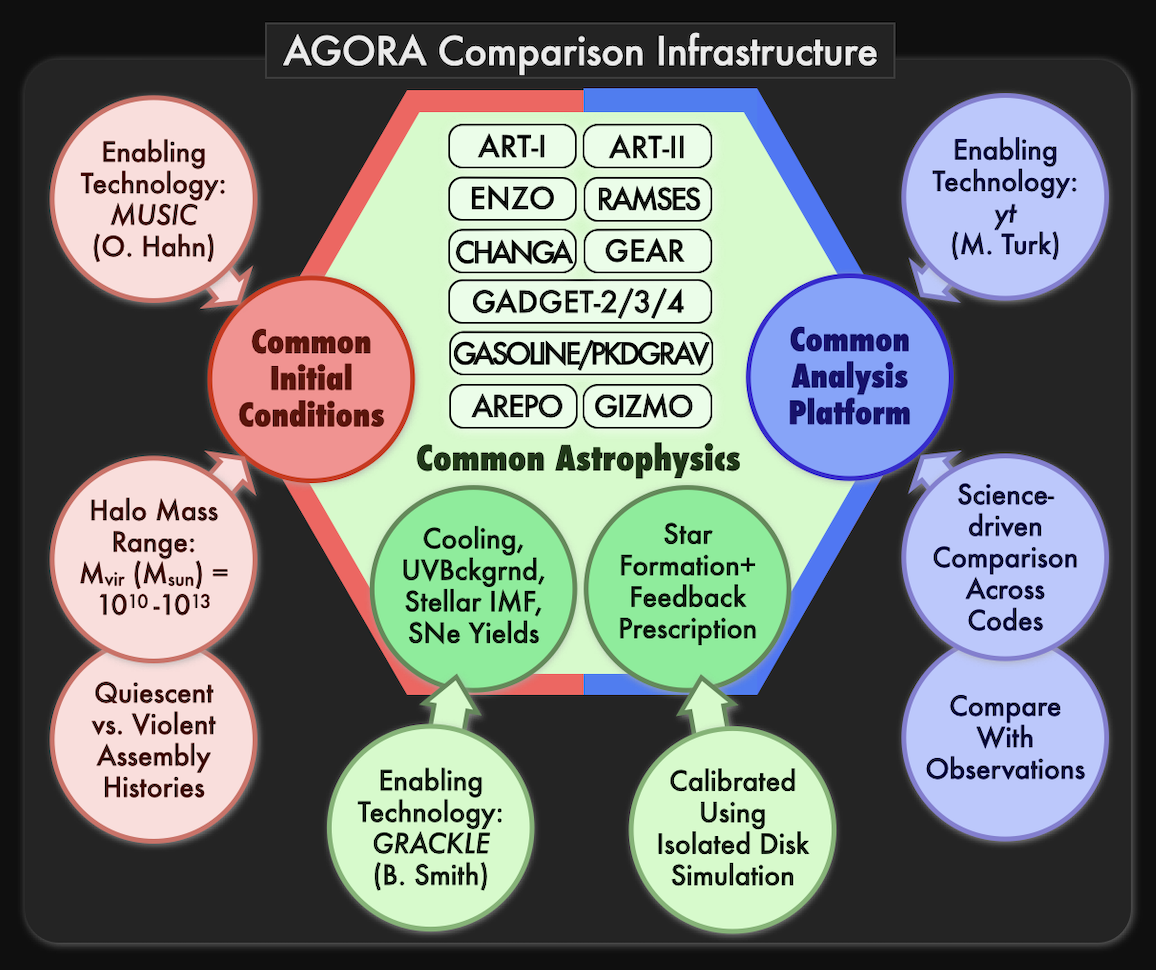
● Kim, H., Kim, J. -H. (corr. author), Jung, M., Roca-Fabrega, S., & 20 other co-authors for the AGORA Collaboration, “The AGORA High-resolution Galaxy Simulations Comparison Project. X: Formation and Evolution of Galaxies at the High-redshift Frontier”, ApJ submitted (2025) [astro-ph:2511.04435] [Local/high-resolution] [Project Website] [Intro Video]
● Jung, M., Kim, J. -H. (corr. author), Nguyen, T. H., Rodriguez-Cardozo, R., Roca-Fabrega, S., & 22 other co-authors for the AGORA Collaboration, “The AGORA High-resolution Galaxy Simulations Comparison Project. VIII: Disk Formation and Evolution of Simulated Milky Way Mass Galaxy Progenitors at 1<z<5”, ApJ 994 (2025) 245 [astro-ph:2505.05720] [Local/high-resolution] [Project Website] [Intro Video]
● Rodriguez-Cardozo, R., Roca-Fabrega, S., Jung, M., Nguyen, T. H., Kim, J. -H., & 17 other co-authors for the AGORA Collaboration, “The AGORA High-resolution Galaxy Simulations Comparison Project. VII: Satellite Quenching in Zoom-in Simulation of A Milky Way-mass Halo”, A&A 698 A303 (2025) [astro-ph:2505.05844] [Local/high-resolution] [Project Website] [Intro Video]
● Roca-Fabrega, S., Kim, J. -H., Primack, J. R., & 9 other co-authors for the AGORA Collaboration, “The AGORA High-resolution Galaxy Simulations Comparison Project: CosmoRun Public Data Release”, [NASA ADS] [astro-ph:2408.00432] [Local/high-resolution] [Project Website]
● Strawn, C., Roca-Fabrega, S., Primack, J. R., Kim, J. -H. (corr. author), & 24 other co-authors for the AGORA Collaboration, “The AGORA High-resolution Galaxy Simulations Comparison Project. VI: Similarities and Differences in the Circumgalactic Medium”, ApJ 962 (2024) 29 [astro-ph:2402.05246] [Local/high-resolution] [Project Website] [Intro Video]
● Jung, M., Roca-Fabrega, S., Kim, J. -H. (corr. author), & 18 other co-authors for the AGORA Collaboration, “The AGORA High-resolution Galaxy Simulations Comparison Project. V: Satellite Galaxy Populations In A Cosmological Zoom-in Simulation of A Milky Way-mass Halo”, ApJ 964 (2024) 123 [astro-ph:2402.05392] [Local/high-resolution] [Project Website] [Intro Video]
● Roca-Fabrega, S., Kim, J. -H. (corr. author), Primack, J. R., Jung, M., & 23 other co-authors for the AGORA Collaboration, “The AGORA High-resolution Galaxy Simulations Comparison Project. IV: Halo and Galaxy Mass Assembly in a Cosmological Zoom-in Simulation at z≤2”, ApJ 968 (2024) 125 [astro-ph:2402.06202] [Local/high-resolution] [Project Website] [Intro Video] [UCM Press Release (Spanish)] [LU Press Release (Swedish)] [UNAM Press Release (Spanish)]
● Roca-Fabrega, S., Kim, J. -H. (corr. author), Hausammann, L., Nagamine, K., & 19 other co-authors for the AGORA Collaboration, “The AGORA High-resolution Galaxy Simulations Comparison Project. III: Cosmological Zoom-in Simulation of A Milky Way-mass Halo”, ApJ 917 (2021) 64 [astro-ph:2106.09738] [Local/high-resolution] [Project Website] [Intro Video] [UCM Press Release (Spanish)] (EuropaPress)
● Shin, E. -J., Kim, J. -H. (corr. author), & Oh, B. K., “How Metals Are Transported In And Out Of A Galactic Disk: Dependence On The Hydrodynamic Schemes In Numerical Simulations”, ApJ 917 (2021) 12 [astro-ph:2106.04640] [Local/high-resolution] [More info at Eun-jin Shin's website]
● Roca-Fabrega, S., Kim, J. -H., Primack, J. R., & 11 other co-authors for the AGORA Collaboration, “The AGORA High-resolution Galaxy Simulations Comparison Project: Public Data Release”, [NASA ADS] [astro-ph:2001.04354] [Local/high-resolution] [Project Website]
● Kim, J. -H., Agertz, O., Teyssier, R., Butler, M. J., Ceverino, D., & 38 other co-authors for the AGORA Collaboration, “The AGORA High-resolution Galaxy Simulations Comparison Project. II: Isolated Disk Test”, ApJ 833 (2016) 202 [astro-ph:1610.03066] [Local/high-resolution] [Project Website]
● Kim, J. -H., Abel, T., Agertz, O., Bryan, G. L., Ceverino, D., & 41 other co-authors for the AGORA Collaboration, “The AGORA High-resolution Galaxy Simulations Comparison Project”, ApJS 210 (2014) 14 [astro-ph:1308.2669] [Local/high-resolution] [Project Website] [1-slide Introduction] [UC-HiPACC AstroShort Article] [UCSC Press Release] (EurekAlert) [UC-HiPACC Press Release] (EurekAlert)
As computational resolution of modern cosmological simulations reach ever so close to resolving individual star-forming clumps in a galaxy, a need for "resolution-appropriate" physics for a galaxy-scale simulation has never been greater. To this end, we introduce a self-consistent numerical framework that includes explicit treatments of feedback from star-forming molecular clouds (SFMCs) and massive black holes (MBHs). In addition to the thermal supernovae feedback from SFMC particles, photoionizing radiation from both SFMCs and MBHs is tracked through full 3-dimensional ray tracing. A mechanical feedback channel from MBHs is also considered. Using our framework, we perform a state-of-the-art cosmological simulation of a quasar-host galaxy at z~7.5 for ~25 Myrs with all relevant galactic components such as dark matter, gas, SFMCs, and an embedded MBH seed of ~> 1e6 Msun. We find that feedback from SFMCs and an accreting MBH suppresses runaway star formation locally in the galactic core region. Newly included radiation feedback from SFMCs, combined with feedback from the MBH, helps the MBH grow faster by retaining gas that eventually accretes on to the MBH.
In another work, we implement a BH growth channel by the accretion of tidally-disrupted stars near the BH (tidal disruption accretion; TDA) to investigate its influence on a MBH seed’s early evolution in a dense nuclear star cluster (NSC) at the center of a high-redshift galaxy. We find that a MBH seed grows rapidly from 1e3 Msun to ~> 106 Msun in 200 Myrs in some of the tested simulations. Compared to a MBH seed that grows only via gas accretion, TDA can enhance the MBH’s growth rate by up to more than an order of magnitude. However, as predicted, TDA mainly helps the early growth of the MBH (from 1e3−4 Msun to <~ 1e5 Msun) while the later evolution is generally dominated by gas accretion. Our experiments demonstrate that previously undiscussed types of interplay between gas, SFMCs, and a MBH may hold important clues about the growth and feedback of quasars and their host galaxies in the high-redshift Universe.
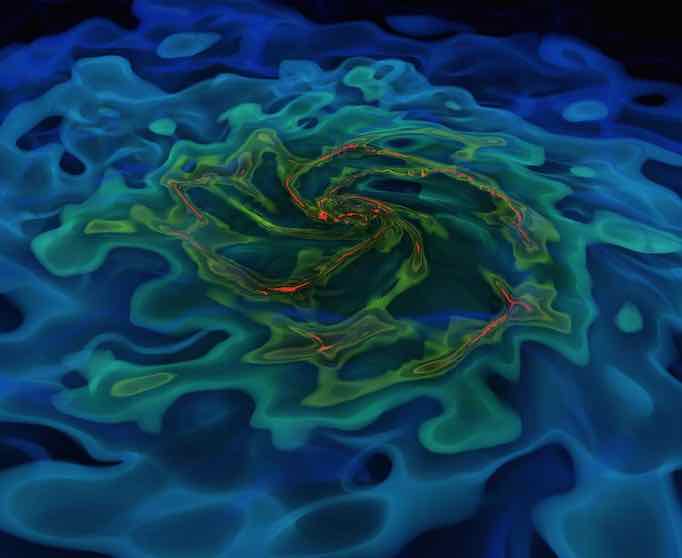
● Lee, S., Lee, H. M., Kim, J. -H. (corr. author), Spurzem, R., Hong, J., & Chung, E., “Formation and Evolution of Compact Binaries Containing Intermediate Mass Black Holes in Dense Star Clusters” , ApJ 988 (2025) 15 [astro-ph:2503.22109] [Local/high-resolution]
● Jo, Y., Jung, M., Bryan, G. L., Kim, S., Kim, J. -H., & Lee, A., “Evolution of Nuclear Star Cluster in Dwarf Galaxy through Mergers and In-Situ Star Formation” , ApJ submitted (2024)
● Jo, Y., Kim, S., Kim, J. -H., & Bryan, G. L., “Evolution of Star Clusters Within Galaxies Using Self-consistent Hybrid Hydro/N-body Simulation” , ApJ 974 (2024) 193 [astro-ph:2408.03128] [Local/high-resolution]
● Lee, S., Kim, J. -H. (corr. author), & Oh, B. K., “Growth of A Massive Black Hole In A Dense Star Cluster Via Tidal Disruption Accretion”, ApJ 943 (2023) 77 [astro-ph:2211.02376] [Local/high-resolution] [Samsung Science & Technology Foundation Article]
● Kim, J. -H., Wise, J. H., Abel, T., Jo, Y., Primack, J. R., & Hopkins, P. F., “High-redshift Galaxy Formation with Self-consistently Modeled Stars and Massive Black Holes: Stellar Feedback and Quasar Growth”, ApJ 887 (2019) 120 [astro-ph:1910.12888] [Local/high-resolution]
● Bryan, G. L. et al. including Kim, J. -H. for the ENZO Collaboration, “Enzo: An Adaptive Mesh Refinement Code for Astrophysics (Version 2.6)”, JOSS 4(42) (2019) 1636 [JOSS Page]
● Bryan, G. L. et al. including Kim, J. -H. for the ENZO Collaboration, “Enzo: An Adaptive Mesh Refinement Code for Astrophysics”, ApJS 211 (2014) 19 [astro-ph:1307.2265]
● Kaehler, R., Abel, T., & Kim, J. -H., “Visualization of a High-resolution Galaxy Formation Simulation”, SuperComputing 2011 Scientific Visualization Companion Proceedings pp.133 (2011), Seattle, WA, November 2011 [Local] [Visualization by Ralf Kaehler]
● Kim, J. -H., Wise, J. H., Alvarez, M. A., & Abel, T., “Galaxy Formation with Self-consistently Modeled Stars and Massive Black Holes. I: Feedback-regulated Star Formation and Black Hole Growth”, ApJ 738 (2011) 54 [astro-ph:1106.4007] [Local/high-resolution] [Selected Plots and Movies] [Astrobites Article] [Visualization by Ralf Kaehler]
● Kim, J. -H., “Galaxy Formation and Mergers with Stars and Massive Black Holes”, Ph.D. Dissertation, Stanford Univ., May 2011 [Stanford Library] [Google Books] [Local]
The recent discovery of diffuse dwarf galaxies that are deficient in dark matter appears to challenge the current paradigm of structure formation in our Universe. Along with their luminous member globular clusters (GCs), the so-called dark matter deficient galaxies (DMDGs) have challenged observers and theorists alike. We report a suite of high-resolution galaxy collision simulations, which demonstrates that high-velocity galaxy collisions separate dark matter from the warm disk gas, and induce the formation of DMDGs and their star clusters (SCs) simultaneously. In particular, we show that a galaxy collision with a high relative velocity of ~300 km/s, invoking severe shock compression, spawns multiple massive SCs (~> 1e6 Msun) within 150 Myr after the collision. At the end of our ~800 Myr fiducial run, the resulting DMDG of M* ~ 3.5e8 Msun hosts 10 luminous (M_V <~ -8.5 mag) gravitational bound SCs with a line-of-sight velocity dispersion 11.2 km/s. Using a large simulated universe IllustrisTNG, we also discover a number of high-velocity galaxy collision events in which DMDGs are expected to form. However, we did not find evidence that these types of collisions actually produced DMDGs in the IllustrisTNG100-1 run. We argue that the resolution of the numerical experiment is critical to realize the "collision-induced" DMDG formation scenario. Our study suggests that galaxies with unconventional dark matter fractions and their luminous member SCs could form simultaneously in high-velocity galaxy collisions while being in line with the key observed properties of NGC1052-DF2 and NGC1052-DF4.
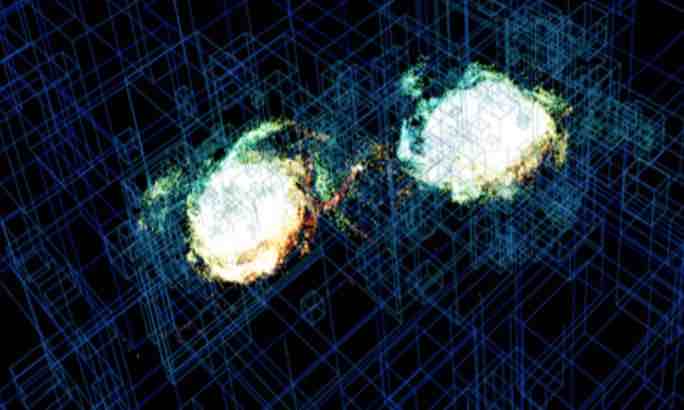
● Lee, J., Shin, E. -J., Kim, J. -H., Shapiro, P. R., & Chung, E. “Multiple Beads-on-a-string: Dark Matter-Deficient Galaxy Formation In A Mini-bullet Satellite-satellite Galaxy Collision” , ApJ 966 (2024) 72 [astro-ph:2312.11350] [Local/high-resolution]
● Shin, E. -J., & Kim, J. -H. (corr. author), “News and Views: Collision Created Galaxies Devoid of Dark Matter”, Nature 605 (2022) 427 [Nature website] [Local/high-resolution]
● Lee, J., Shin, E. -J., & Kim, J. -H. (corr. author), “Dark Matter Deficient Galaxies And Their Member Star Clusters Form Simultaneously During High-velocity Galaxy Collisions In 1.25 pc Resolution Simulations”, ApJ Letters 917 (2021) L15 [astro-ph:2108.01102] [Local/high-resolution] [SNU Physics Research Highlights Article] [More info at Joohyun Lee's website]
● Shin, E. -J., Jung, M., Kwon, G., Kim, J. -H. (corr. author), Lee, J., Jo, Y., & Oh, B. K., “Dark Matter Deficient Galaxies Produced Via High-velocity Galaxy Collisions In High-resolution Numerical Simulations”, ApJ 899 (2020) 25 [astro-ph:2007.09889] [Local/high-resolution] [More info at Eun-jin Shin's website]
● Kim, J. -H., Wise, J. H., & Abel, T., “Galaxy Mergers with Adaptive Mesh Refinement: Star Formation and Hot Gas Outflow”, ApJ Letters 694 (2009) L123 [astro-ph:0902.3001] [Local/high-resolution] [Selected Plots and Movies] [KIPAC Computing Article] [Visualization by Ralf Kaehler]
We have developed a pipeline to estimate baryonic properties of a galaxy inside a dark matter (DM) halo in DM-only simulations using a machine trained on high-resolution hydrodynamic simulations. As an example, we use the IllustrisTNG hydrodynamic simulation of a (75 Mpc/h)^3 volume to train our machine to predict e.g., stellar mass and star formation rate in a galaxy-sized halo based purely on its DM content. An extremely randomized tree (ERT) algorithm is used together with multiple novel improvements we introduce here such as a refined error function in machine training and two-stage learning. Aided by these improvements, our model demonstrates a significantly increased accuracy in predicting baryonic properties compared to prior attempts -- in other words, the machine better mimics IllustrisTNG's galaxy-halo correlation. By applying our machine to the MultiDark-Planck DM-only simulation of a large (1 Gpc/h)^3 volume, we then validate the pipeline that rapidly generates a galaxy catalogue from a DM halo catalogue using the correlations the machine found in IllustrisTNG. Our so-called machine-assisted semi-simulation model (MSSM) is shown to be largely compatible with popular semi-analytic models (SAMs), and may become a promising method to transplant the baryon physics of galaxy-scale hydrodynamic calculations onto a larger-volume DM-only run.
In another application of machine-assisted numerical cosmology, we have developed a novel method with machine learning to calibrate subgrid models within numerical simulations to achieve convergence with observations and between different codes, by utilizing active learning and neural density estimators. Using a set of 22 cosmological zoom-in simulations, we tune the parameters of a popular star formation and feedback model within Enzo to match observations. The parameters that are adjusted include the star formation efficiency, coupling of thermal energy from stellar feedback, and volume into which the energy is deposited. This number translates to a factor of more than three improvements over manual calibration. Despite using fewer simulations, we obtain a better agreement to the observed baryon makeup of a Milky Way-sized halo. The exploration and calibration of the parameters of the subgrid models with a machine learning approach is concluded to be versatile and directly applicable to different problems.
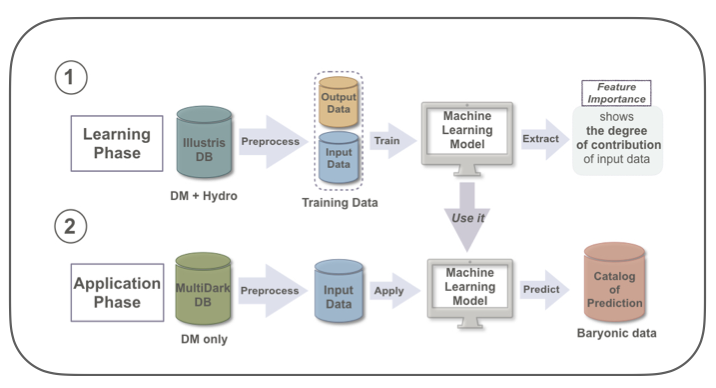
● Lee, J. -Y., Kim, J. -H. (corr. author), Jung, M., & 6 other co-authors, “Inferring Cosmological Parameters on SDSS via Domain-Generalized Neural Networks and Lightcone Simulations” , ApJ 975 (2024) 38 [astro-ph:2409.02256] [Local/high-resolution]
● Jung, M., Kim, J. -H. (corr. author), Oh, B. K., Hong, S. E., Lee, J., & Kim, J., “Merger-tree-based Galaxy Matching: A Comparative Study Across Different Resolutions” , ApJ 965 (2024) 156 [astro-ph:2312.02466] [Local/high-resolution]
● Jo, Y. et al. including Kim, J. -H., “Calibrating Cosmological Simulations with Implicit Likelihood Inference Using Galaxy Growth Observables”, ApJ 944 (2023) 67 [astro-ph:2211.16461]
● Oh, B. K., An, H., Shin, E. -J., Kim, J. -H. (corr. author), & Hong, S. E., “Machine-guided Exploration and Calibration of Astrophysical Simulations”, MNRAS 515 (2022) 693 [astro-ph:2203.06914] [Local/high-resolution]
● Jo, Y., & Kim, J. -H. (corr. author), “Machine-assisted Semi-Simulation Model (MSSM): Estimating Galactic Baryonic Properties from Their Dark Matter Using A Machine Trained on Hydrodynamic Simulations”, MNRAS 489 (2019) 3565 [astro-ph:1908.09844] [Local/high-resolution] [More info at Yongseok Jo's website]
Using a state-of-the-art cosmological simulation of merging proto-galaxies at high redshift from the FIRE project, with explicit treatments of star formation and stellar feedback in the interstellar medium, I have investigated the formation of star clusters and examine one of the formation hypothesis of present-day metal-poor globular clusters. We found that frequent mergers in high-redshift proto-galaxies could provide a fertile environment to produce long-lasting bound star clusters. The violent merger event disturbs the gravitational potential and pushes a large gas mass of ~>1e5−6 Msun collectively to high density, at which point it rapidly turns into stars before stellar feedback can stop star formation. The high dynamic range of the FIRE simulation is critical in realizing such dense star-forming clouds with a small dynamical timescale less than 3 Myr, shorter than most stellar feedback timescales. The simulation then allows us to trace how clusters could become virialized and tightly-bound to survive for up to ~420 Myr till the end of the simulation. Because the cluster’s tightly-bound core was formed in one short burst, and the nearby older stars originally grouped with the cluster tend to be preferentially removed, at the end of the simulation the cluster has a small age spread.
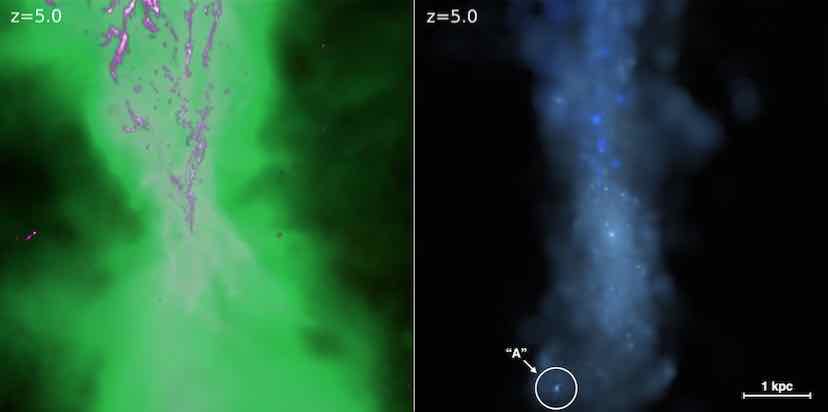
● Ma, X. et al. including Kim, J. -H., “Self-consistent Proto-Globular Cluster Formation in Cosmological Simulations of High-redshift Galaxies”, MNRAS 493 (2020) 4315 [astro-ph:1906.11261]
● Kim, J. -H., Ma, X., Grudic, M. Y., Hopkins, P. F., Hayward, C. C., & 5 other co-authors for the FIRE Collaboration, “Formation of Globular Cluster Candidates in Merging Proto-galaxies at High Redshift: A View from the FIRE Cosmological Simulations”, MNRAS 474 (2018) 4232 [astro-ph:1704.02988] [Local/high-resolution]
● Hopkins, P. F. et al. including Kim, J. -H., “The FIRE-2 Simulations: Physics versus Numerics in Galaxy Formation”, MNRAS 480 (2018) 800 [astro-ph:1702.06148]
● Wetzel, A., Hopkins, P. F., Kim, J. -H., Faucher-Giguere, C-A., Keres, D., & Quataert, E., “Reconciling Dwarf Galaxies with LCDM Cosmology: Simulating A Realistic Population of Satellites Around A Milky Way-Mass Galaxies”, ApJ Letters 827 (2016) L23 [astro-ph:1602.05957] [Caltech News Article]
I have developed a comprehensive description of stellar feedback in a galaxy simulation by combining the ultraviolet (UV) radiation from star clusters and the thermal energy of supernova explosions. In this method, which we call star-forming molecular cloud (SFMC) particles, we use a ray-tracing technique to follow the ultraviolet photons emitted by thousands of distinct particles on the fly. I have applied the realistic description of stellar feedback to a dwarf-sized galactic halo of 2.3e11 Msun with high spatial resolution. By tracing UV photons from thousands of SFMC particles, this feedback scheme has enabled us to study the escape of ionizing photons from an individual SFMC particle and from a galaxy, and to examine the evolving environment of star-forming clouds. I have discovered that the overall UV escape fraction is dominated by a small number of SFMCs with high escape fractions. In addition, the escape fraction from a SFMC particle on average rises from 0.27% at its birth to 2.1% at the end of its lifetime, 6 Myrs. This is because SFMCs drift away from the dense clumps in which they were born, and because the gas around the them is dispersed by stellar feedback.
Because we self-consistently locate the ionized gas, we can make mock observations of Hα emission, a star formation rate (SFR) tracer. With this, I have made a direct comparison between simulated and observed galaxies, and studied how stellar feedback manifests itself in the spatially-resolved star formation relation. I find that the correlation between SFR density (by mock Hα) and H2 density shows large scatter, especially at high resolutions of 75 pc that are comparable to the size of giant molecular clouds (GMCs). This is because an aperture of GMC size captures only particular stages of GMC evolution, and because Hα traces hot gas around star-forming regions, displaced from the H2 peaks themselves.
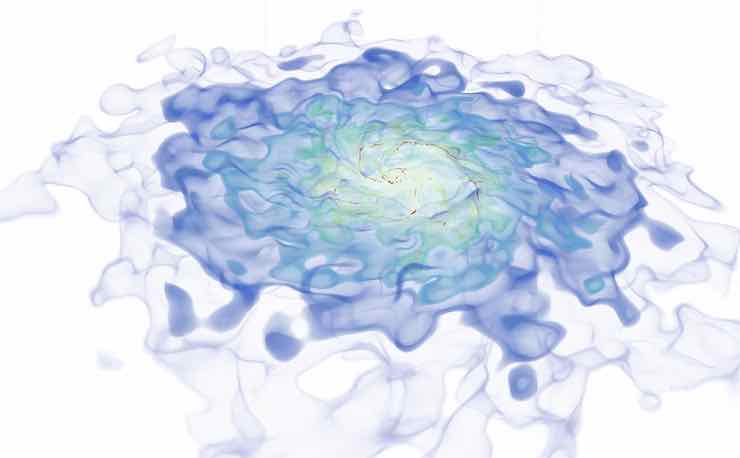
● Shin, E. -J, Tacchella, S., Kim, J. -H., Iyer, K. G., & Semenov, V. A., “Star Formation Variability As A Probe For the Baryon Cycle Within Galaxies”, ApJ 947 (2023) 61 [astro-ph:2211.01922] [Local/high-resolution]
● Butsky, I., Zrake, J., Kim, J. -H., Yang, H. -I., & Abel, T., “Ab Initio Simulations of A Supernova Driven Galactic Dynamo in An Isolated Disk Galaxy”, ApJ 843 (2017) 113 [astro-ph:1610.08528] [Local/high-resolution]
● Pineda, J. L. et al. including Kim, J. -H., “Bridging the Gap: Observations and Theory of Star Formation Meet on Large and Small Scales - Study Report”, Keck Institute for Space Studies Report, Pasadena, CA, November 2014 [Caltech Library] [Local]
● Kim, J. -H., & Lee, J., “How Does the Surface Density and Size of Disk Galaxies Measured in Hydrodynamic Simulations Correlate with the Halo Spin Parameter?”, MNRAS 432 (2013) 1701 [astro-ph:1210.8321] [Local/high-resolution]
● Kim, J. -H., Krumholz, M. R., Wise, J. H., Turk, M. J., Goldbaum, N. J., & Abel, T., “Dwarf Galaxies with Ionizing Radiation Feedback. II: Spatially-resolved Star Formation Relation”, ApJ 779 (2013) 8 [astro-ph:1210.6988] [Local/high-resolution]
● Kim, J. -H., Krumholz, M. R., Wise, J. H., Turk, M. J., Goldbaum, N. J., & Abel, T., “Dwarf Galaxies with Ionizing Radiation Feedback. I: Escape of Ionizing Photons”, ApJ 775 (2013) 109 [astro-ph:1210.3361] [Local/high-resolution] [KIPAC Research Highlights Article]
● Kim, J. -H., Wise, J. H., & Abel, T., “Galaxy Evolution on Adaptive Mesh Refinement”, AIP Conference Proceedings Vol. 990 (2008) 429, First Stars III Conference, Santa Fe, NM, July 2007 [Local/high-resolution] [Selected Plots and Movies]